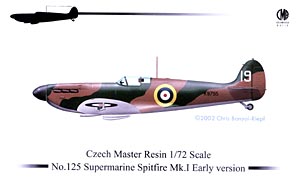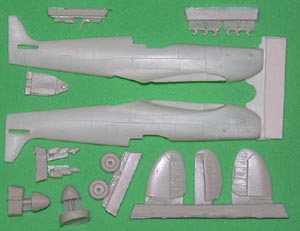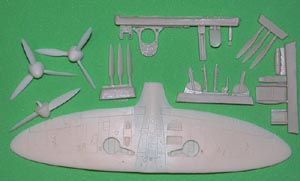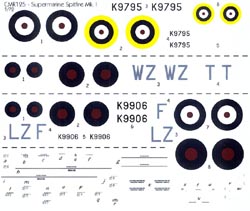Czech Master Resin 1/72 Spitfire Mk. I Early Version |  | History The Spitfire's general history is too well known to be worth going into here. For this particular subject it will suffice to say that, externally, the early Mk.1 production airplanes differed little from the prototype K5054. The main recognition points of difference are: the production articles had tailwheels instead of skids, three-branch exhaust pipes instead of flush outlets and no inner covers for the retracted wheels.  The Kit The Kit
Another terrific winner from Peter Buchar's CMR organization. Because it is such an historically significant subject, I'll be a bit more thorough and critical than I usually am. FUSELAGE: Clearly, this is the fuselage from CMR's recent Spitfire prototype kit with two alternate exhausts provided to install over the flush ports of K5054. Basic cockpit sidewall detail is molded integrally with each fuselage half. If you build the model with the hood closed this will suffice; otherwise install an aftermarket interior. The rudder push/pull rod and its fairing are missing from the left side of the fuselage. WINGS: These are one piece tip-to-tip and include the entire root fairing with the underside "gulling" of the aft center section. My only complaint is that the ailerons are not as well detailed as I'd like and there is an attempt at "texture" in the fabric. In 1:1 scale this degree of texture would only be found in a freshly made, unused, burlap bag! Properly doped and sanded (rubbed down) fabric on an airplane is as smooth as the finish on the hood (bonnet) of your car. The trailing edges are amazingly sharp and thin. EMPENNAGE: The fin is molded with the fuselage halves. The rudder and both tailplanes are molded on the same feed bar. Again, the dreaded fabric "texture" is present and should be expunged. There is no control horn on the left side of the rudder to connect with the push/pull rod missing from the fuselage.  PROPELLER: The Watts one-piece, fixed pitch, wooden prop is pretty good. All you need to do to make it perfect is to twist the blades so that the pitch decreases from the, as molded, high (coarse) pitch at the slowly moving root to the lower (fine) pitch at the more rapidly moving tips. Two one-piece, three blade propellers and two four-piece three blade propellers are included for your spares box. Clearly, more Spits are coming from CMR. PROPELLER: The Watts one-piece, fixed pitch, wooden prop is pretty good. All you need to do to make it perfect is to twist the blades so that the pitch decreases from the, as molded, high (coarse) pitch at the slowly moving root to the lower (fine) pitch at the more rapidly moving tips. Two one-piece, three blade propellers and two four-piece three blade propellers are included for your spares box. Clearly, more Spits are coming from CMR.
CANOPY: Two straight sided, flat topped windscreen/hood units are provided along with two straight sided, bulged top units. DETAILS: you get a later style pitot for your spares box along with the two-tube type appropriate to the subject. The five-spoke wheels are fine. Detail on the landing gear legs is a bit soft. The gear covers are too thick. The radiator housing and core and the oil cooler are fine. In addition to the previously noted cockpit sidewall detail molded onto the fuselage halves, CMR correctly provide a central channel instead of a floor for the cockpit along with fore and aft cockpit bulkheads and a separate seat. The fwd. bulkhead includes the high relief instrument panel. A separate stick and rudder pedals are provided.  DECALS: Here, I'm sorry to say, CMR dropped the ball - or at least their decal vendor did. The black instead of blue of the national insignia renders them useless. The decal sheet does, however, include all of the tiny stenciling that adds so much to the verisimilitude of a finished model. Three color schemes with Dark earth and Dark Green topsides are provided; two of the three - K9795 of 19 Sqdn., Duxford, October 1938 and K9906 of 65 Sqdn., Hornchurch, July 1939 - have aluminum painted undersurfaces. The third - K9794 of 19 Sqdn., Duxford, May 1939 - has the black/white undersides briefly used from April through June 1939. This was a time of chaos all over Europe and interpretation of Air Ministry Order A.154/39, amended by A.298.39, which set out the black/white undersides requirement, varied widely. The Ducimus book noted below is a good guide to this arcane subject. DECALS: Here, I'm sorry to say, CMR dropped the ball - or at least their decal vendor did. The black instead of blue of the national insignia renders them useless. The decal sheet does, however, include all of the tiny stenciling that adds so much to the verisimilitude of a finished model. Three color schemes with Dark earth and Dark Green topsides are provided; two of the three - K9795 of 19 Sqdn., Duxford, October 1938 and K9906 of 65 Sqdn., Hornchurch, July 1939 - have aluminum painted undersurfaces. The third - K9794 of 19 Sqdn., Duxford, May 1939 - has the black/white undersides briefly used from April through June 1939. This was a time of chaos all over Europe and interpretation of Air Ministry Order A.154/39, amended by A.298.39, which set out the black/white undersides requirement, varied widely. The Ducimus book noted below is a good guide to this arcane subject.
INSTRUCTIONS: These are excellent. Six sides of A4 size are clearly printed and feature sharp, clear graphics that "self instruct" with very little attendant verbiage. These instructions are a model for the industry. Conclusion I like it. Built out-of-the-bag the kit will easily produce a fine accurate model. What more can you ask of a kit? References SPITFIRE - THE HISTORY: E. B. Morgan & E. Shacklady, Key Publishing, Ltd., Stamford, Lincs., 1987, ISBN 0-946219-109. CAMOUFLAGE & MARKINGS NUMBER ONE - RAF NORTHERN EUROPE 1936-45; SUPERMARINE SPITFIRE: J. GOULDING, Ducimus Books, London, undated. THE SPITFIRE STORY: A. Price, Jane's, London, 1982, ISBN 0-86720-6241. BRITISH AVIATION COLOURS OF WORLD WAR TWO (The Official Camouflage Colours & Markings of RAF Aircraft, 1939-1945: RAF Museum Series, Vol. 3, J. Tanner, Arms and Armour Press, London. 1986, ISBN 0-85368-271-2. VICKERS-SUPERMARINE SPITFIRE Mk.1 - V: Aero Detail, Tokyo, 1993, ISBN 4-499-22617-1. SPITFIRE, A DOCUMENTARY HISTORY: A. P. price, Scribners, New York, 1979, ISBN 0-684-16060-9. | 







|

 The Kit
The Kit PROPELLER: The Watts one-piece, fixed pitch, wooden prop is pretty good. All you need to do to make it perfect is to twist the blades so that the pitch decreases from the, as molded, high (coarse) pitch at the slowly moving root to the lower (fine) pitch at the more rapidly moving tips. Two one-piece, three blade propellers and two four-piece three blade propellers are included for your spares box. Clearly, more Spits are coming from CMR.
PROPELLER: The Watts one-piece, fixed pitch, wooden prop is pretty good. All you need to do to make it perfect is to twist the blades so that the pitch decreases from the, as molded, high (coarse) pitch at the slowly moving root to the lower (fine) pitch at the more rapidly moving tips. Two one-piece, three blade propellers and two four-piece three blade propellers are included for your spares box. Clearly, more Spits are coming from CMR. DECALS: Here, I'm sorry to say, CMR dropped the ball - or at least their decal vendor did. The black instead of blue of the national insignia renders them useless. The decal sheet does, however, include all of the tiny stenciling that adds so much to the verisimilitude of a finished model. Three color schemes with Dark earth and Dark Green topsides are provided; two of the three - K9795 of 19 Sqdn., Duxford, October 1938 and K9906 of 65 Sqdn., Hornchurch, July 1939 - have aluminum painted undersurfaces. The third - K9794 of 19 Sqdn., Duxford, May 1939 - has the black/white undersides briefly used from April through June 1939. This was a time of chaos all over Europe and interpretation of Air Ministry Order A.154/39, amended by A.298.39, which set out the black/white undersides requirement, varied widely. The Ducimus book noted below is a good guide to this arcane subject.
DECALS: Here, I'm sorry to say, CMR dropped the ball - or at least their decal vendor did. The black instead of blue of the national insignia renders them useless. The decal sheet does, however, include all of the tiny stenciling that adds so much to the verisimilitude of a finished model. Three color schemes with Dark earth and Dark Green topsides are provided; two of the three - K9795 of 19 Sqdn., Duxford, October 1938 and K9906 of 65 Sqdn., Hornchurch, July 1939 - have aluminum painted undersurfaces. The third - K9794 of 19 Sqdn., Duxford, May 1939 - has the black/white undersides briefly used from April through June 1939. This was a time of chaos all over Europe and interpretation of Air Ministry Order A.154/39, amended by A.298.39, which set out the black/white undersides requirement, varied widely. The Ducimus book noted below is a good guide to this arcane subject.






